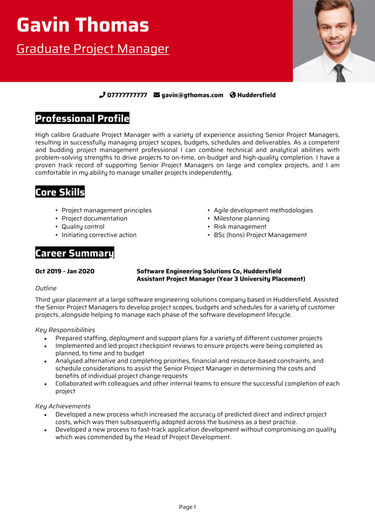You might not have a long list of jobs behind you – but don’t underestimate what you bring to the table. Whether you’re applying for part-time work, volunteering, or an apprenticeship, your CV is your chance to show that you’re motivated and ready to learn.
This guide (with a High School Student CV example) will help you turn your school experience and personal strengths into a professional CV that opens doors – even if you’re just getting started.
High School Student CV
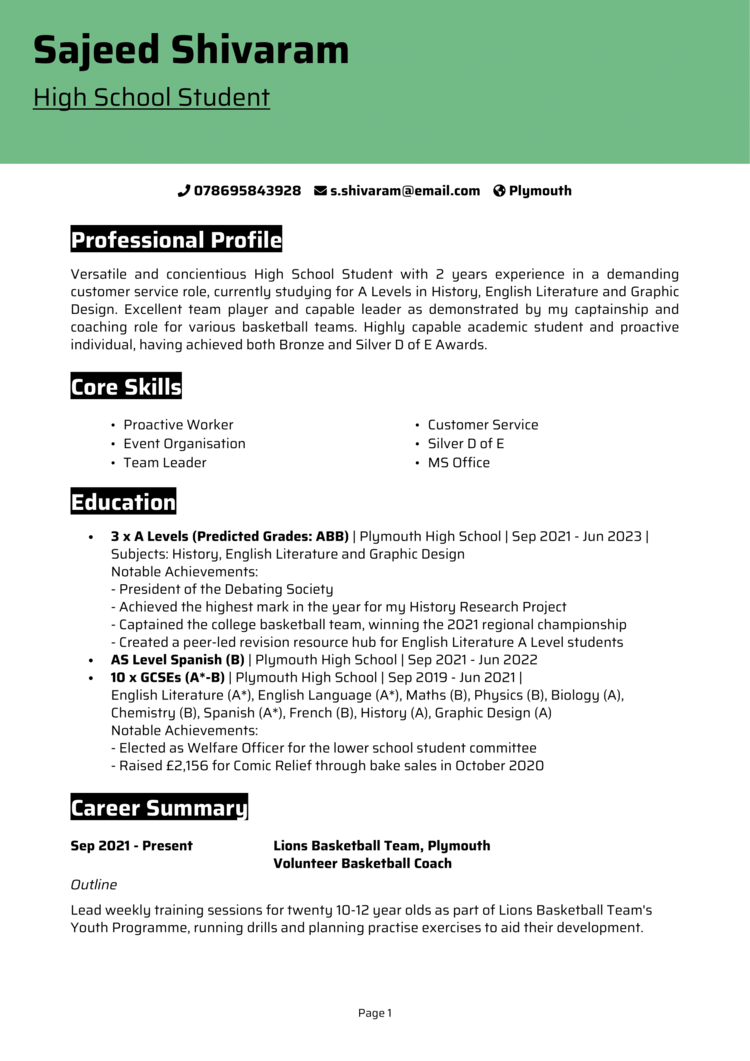
How to write your High School Student CV
Discover how to create a quality High School Student CV with this simple step-by-step guide.
Everyone has to start somewhere – and your CV is where you show potential employers why that somewhere should be with them. Even without formal work experience, you’ve already built valuable skills through school, group work, extracurriculars, and responsibilities at home.
In this guide, you’ll learn about writing a CV clearly in order to highlight the skills you already have and create a first impression that helps you stand out from the crowd.
How to structure and format your High School Student CV
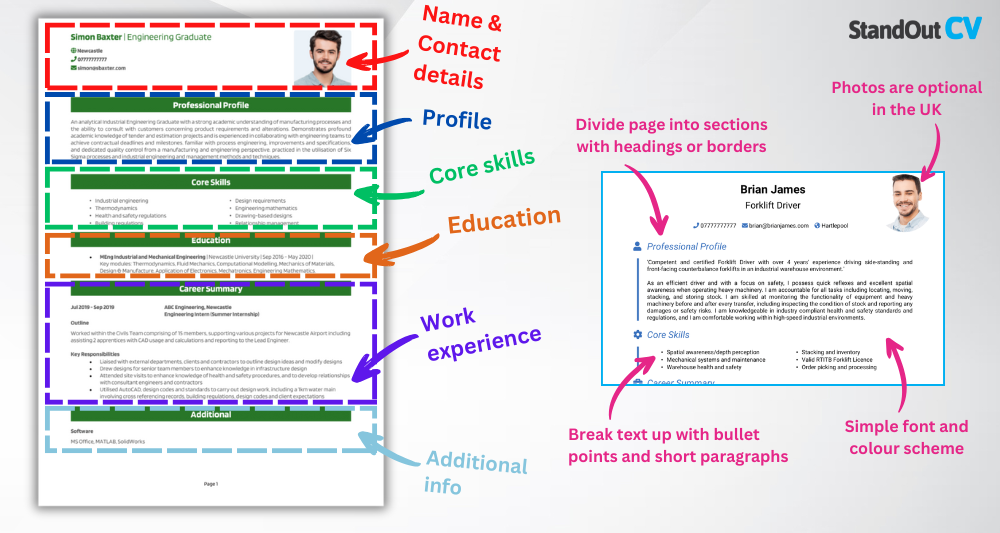
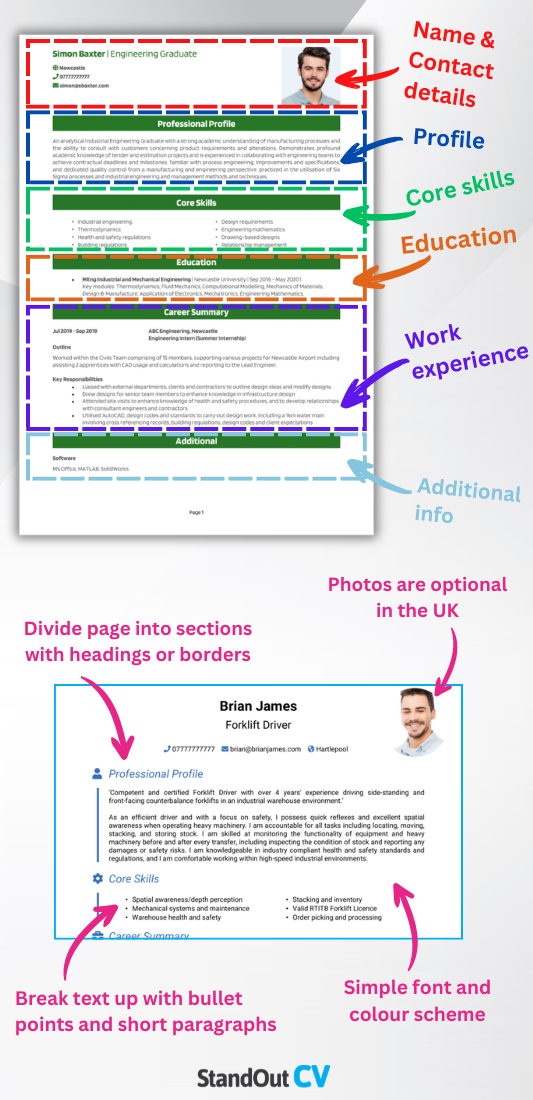
Your CV should be as neat and well-organised as your best school project. A clear CV structure helps employers quickly see what you can offer – even if it’s your first job application. Recruiters are busy (and pretty lazy), so make sure your information is easy to navigate through and understand.
Here’s the layout to follow:
- Name and contact details – Place these personal details at the top so employers can get in touch easily. A photo is always optional, so don’t worry about including one.
- Profile – Kick things off with a concise overview of what makes you the ideal candidate for the job, and what sort of roles you’re aspiring to.
- Core skills – Bullet point key qualities you’ve developed through school or hobbies.
- Work experience – List any previous roles in reverse chronological order, with your most recent first.
- Education & certifications – List your current school and any qualifications you’re working towards.
- Additional info – Optionally add hobbies, interests, or achievements that show responsibility or enthusiasm.
Stick to a one page length if you can, use bullet points to keep things tidy, divide each section with a heading, and choose a clean, easy-to-read font. A neat CV, free of any mistakes, tells employers you care about presentation and can communicate clearly: so don’t underestimate your format.
How to write a High School Student CV profile
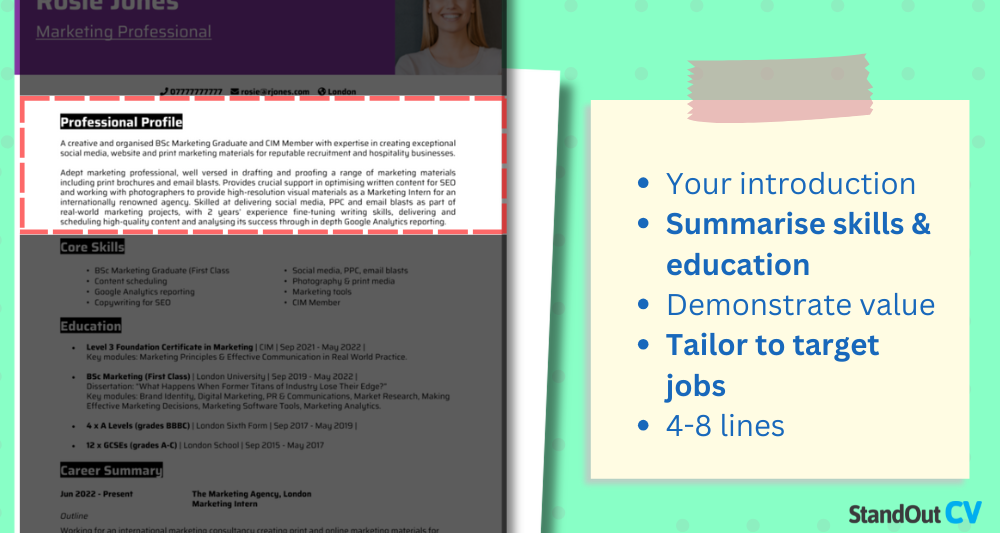
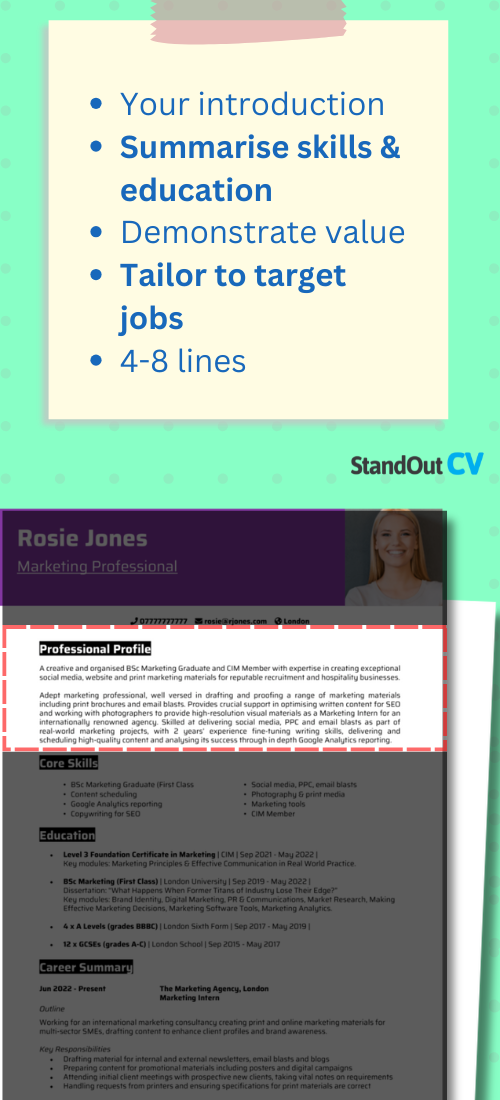
Think of your CV profile (or your personal statement) as your introduction – it should quickly tell employers who you are, what you’re good at, and what you’re looking for. You don’t need years of experience to make a great impression – just show that you’re responsible and willing to learn.
Since there can be quite a lot to discuss, a cover letter is also recommended to attach alongside your CV.
High School Student CV profile examples
Profile 1
Motivated and enthusiastic high school student with a strong academic track record and a keen interest in developing workplace skills. Confident communicator and quick learner, experienced in working collaboratively through school projects and extracurricular activities. Eager to gain hands-on experience in a professional environment while continuing to grow personally and academically.
Profile 2
Reliable and hardworking secondary school student currently completing GCSEs. Demonstrates strong organisational and time-management skills through balancing academic work with volunteering and sports involvement. Known for being dependable, polite, and eager to take on new challenges. Seeking part-time or entry-level opportunities to build experience and contribute to a team.
Things to have in your High School Student CV profile
Here’s what to include:
- Where you are now – Mention your current year in school and your focus areas if relevant.
- Your top qualities – Highlight strengths like reliability, communication, or time management.
- Skills you’ve developed – Mention teamwork, customer service, or problem-solving.
- The type of role you want – Whether it’s part-time retail, a weekend job, or a summer internship.
- Your attitude – Show that you’re keen, adaptable, and ready to take on new challenges.
What to include in the core skills section of your CV
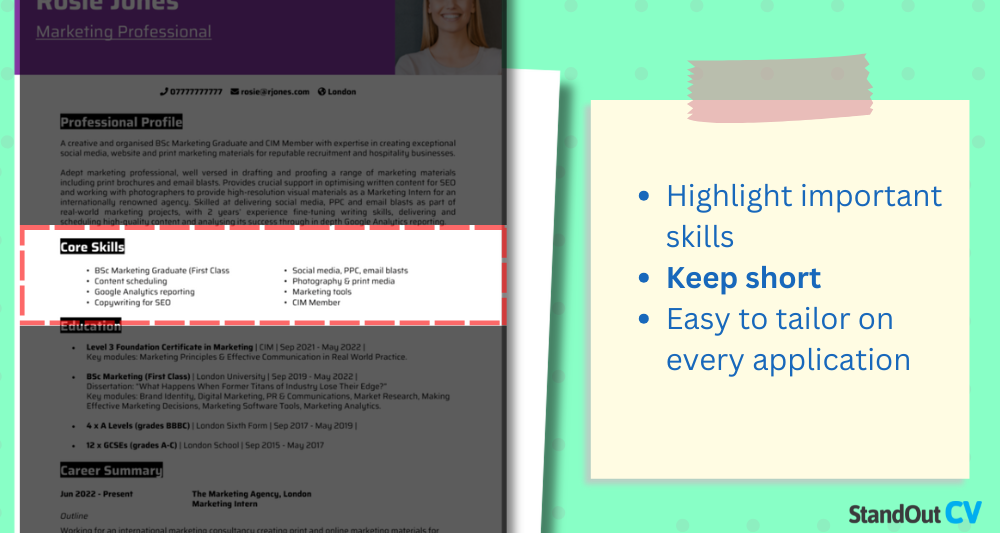
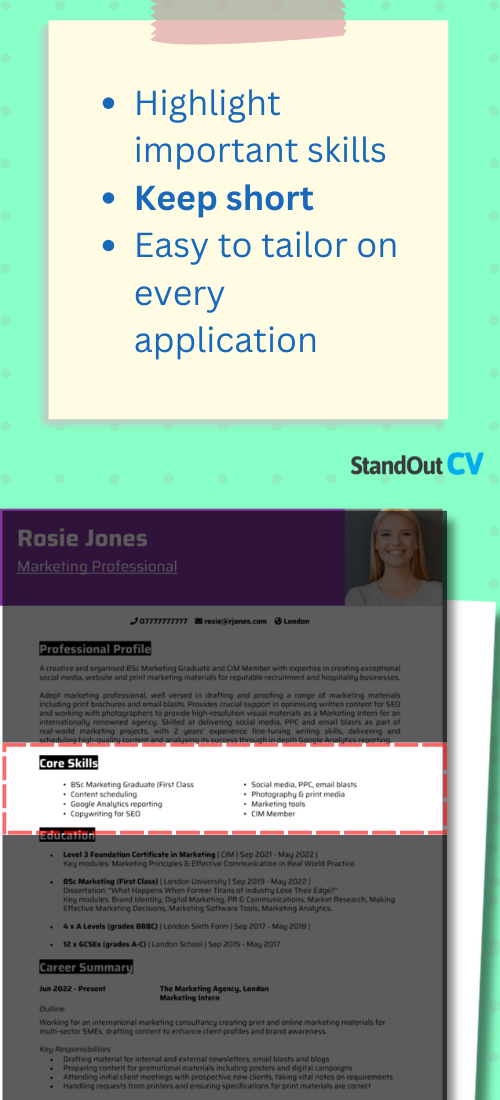
This section is perfect for showing what you’re already good at – even if you haven’t had a job yet. Think about school projects or hobbies that demonstrate your strengths.
Rather than vague traits like “hard worker,” focus on practical skills: communication, teamwork, basic IT, punctuality, or customer service. It’s also one of the easiest parts of your CV to tailor between different jobs – just adjust your skills based on what the recruiters are asking for.
What are the most important skills for a High School Student CV?
- Time Management – Balancing schoolwork, extracurricular activities, and personal responsibilities effectively.
- Study and Revision Techniques – Using structured methods to prepare for exams, complete assignments, and retain information.
- Team Collaboration – Working in group projects, sports, or clubs, developing strong cooperation and interpersonal skills.
- Technology Proficiency – Using digital tools like Google Workspace, Microsoft Office, and online learning platforms for schoolwork.
- Critical Thinking and Problem Solving – Applying logic and analysis to solve problems across subjects like math, science, and humanities.
- Communication Skills – Expressing ideas clearly in written assignments, presentations, and class discussions.
- Organisation and Planning – Keeping track of deadlines, managing homework, and maintaining tidy notes and study materials.
- Adaptability and Learning Agility – Adjusting to different teaching styles, subjects, and learning environments.
- Leadership and Initiative – Taking on roles in student council, clubs, or peer mentoring to support the school community.
- Goal Setting and Self-Motivation – Setting academic and personal goals and working consistently to achieve them.
How to list your educational history
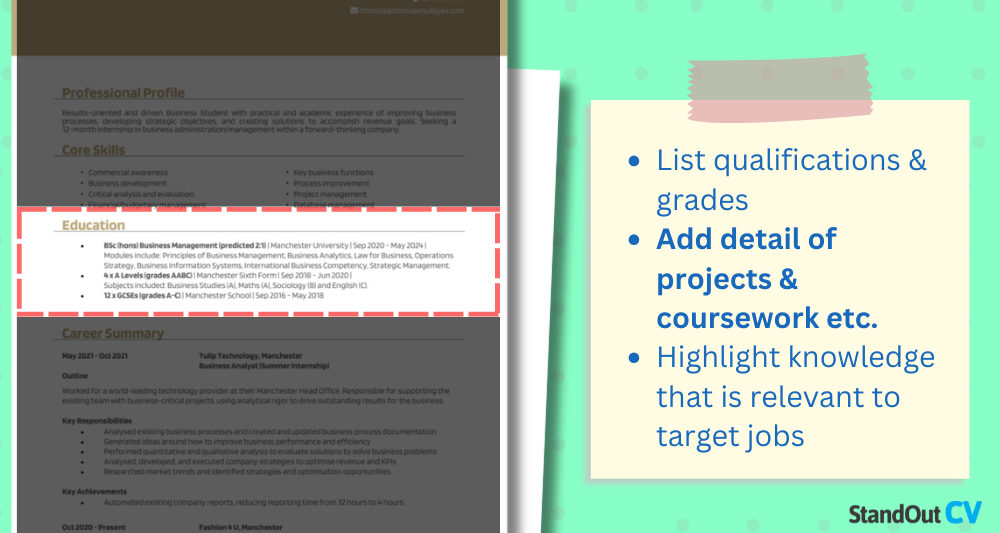

As a student, your education will likely be your strongest section – so make sure it’s clear. List your current school, year group, and any qualifications you’re studying for (e.g. GCSEs, Highers, etc.). Include predicted grades if relevant.
You can also include awards, coursework projects, school roles (e.g. prefect or form rep), and any training you’ve completed – like first aid or online courses.
Example education sections
Education 1
GCSEs (Predicted: 7x Grades 7–9) | Brookfield High School | 2021–2024
Subjects include English Language, English Literature, Maths, Combined Science, History, Art & Design, and French.
Currently working towards final exams with strong predicted grades in core subjects.
Member of the school’s student council and debate team.
Education 2
GCSEs (Completed) | Northvale Secondary School | 2020–2023
Achieved 9x GCSEs including:
English Language – 8
Mathematics – 7
Biology – 8
Chemistry – 7
History – 9
Spanish – 6
Actively involved in school volunteering programme and participated in Duke of Edinburgh Bronze Award
What to include in your education section
For each qualification, add the following info:
- Qualification & organisation – Name the qualification (e.g. GCSE) and the awarding body (your school).
- Dates studied – Let the recruiter know the year you started and the year you end (or expect to end).
- Extra details – Specific subjects and projects might have taught you important, valuable skills. If relevant to the jobs you’re going for, feel free to expand on them.
What are the best qualifications for a High School Student CV?
- GCSEs (or equivalent) – Highlight your core subjects and predicted/achieved grades.
- Duke of Edinburgh’s Award – Shows initiative, teamwork, and community involvement.
- First Aid Training – Demonstrates responsibility and preparedness.
- Food Hygiene Certificate – Great for catering or hospitality roles.
- School leadership or club roles – Proves initiative and communication skills.
How to write a strong work experience section for your CV
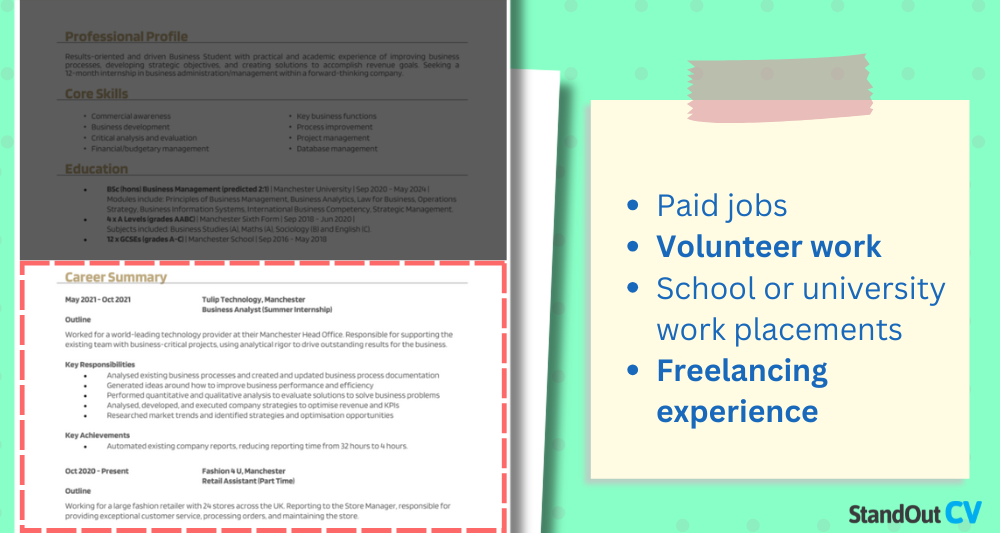
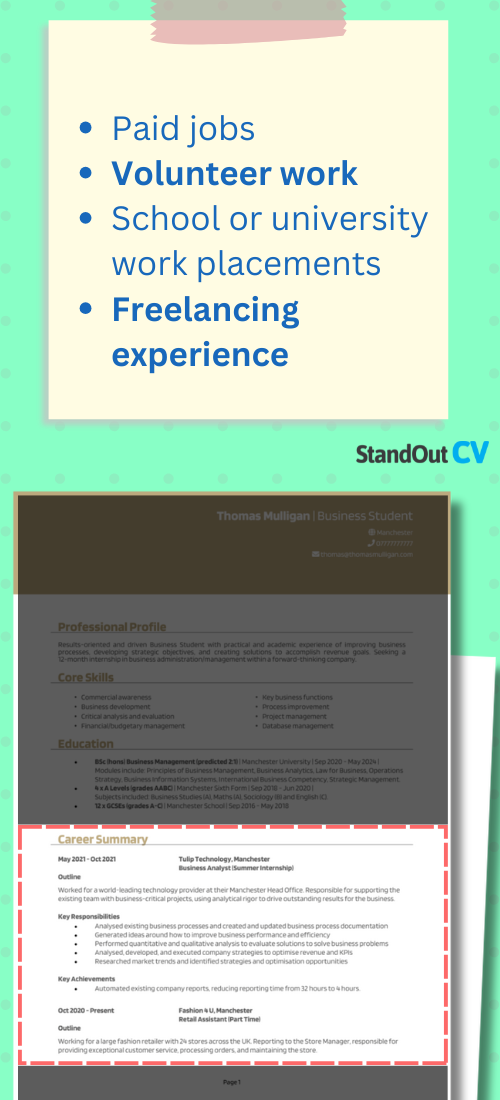
In the work experience section, you should list all of your previous jobs in reverse chronological order to prove how you can apply your skills and knowledge in the workplace. Even if you have no experience, this section is still vital.
Don’t worry if you haven’t had a paid job yet – work experience comes in many forms. Think about helping at school events, volunteering, babysitting, tutoring, running a club, or doing odd jobs for neighbours or family.
List your experiences starting with the most recent. Include what you did, when you did it, and what you learned or achieved. Focus on reliability or responsibility – even if it was something informal.
Structuring your jobs
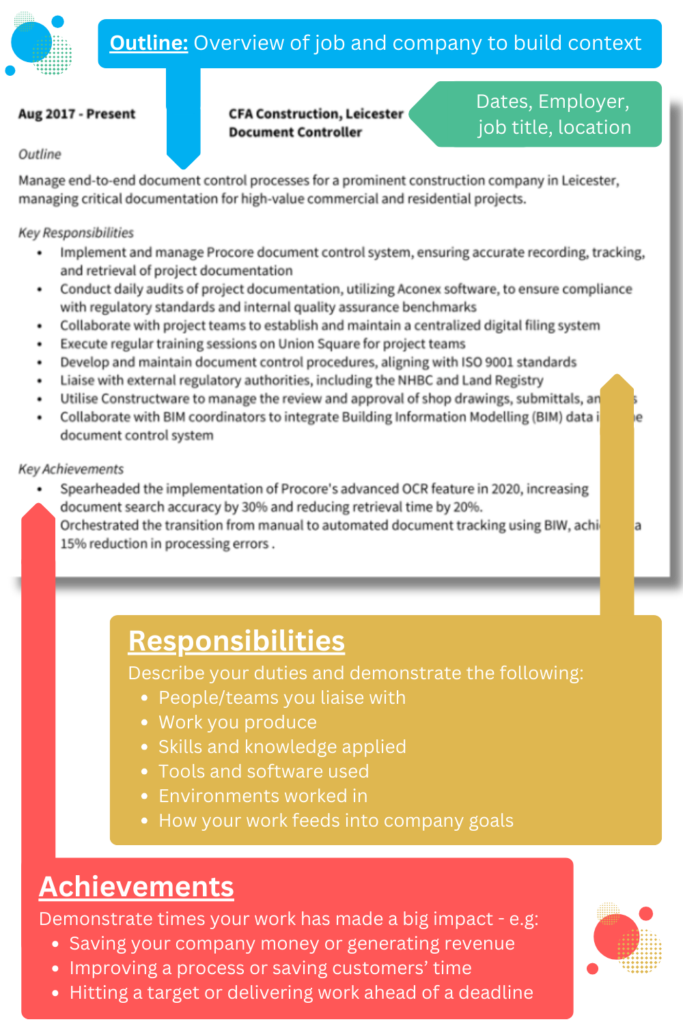
- Outline – Explain what the experience was and where it took place.
- Responsibilities – Use action words like “helped,” “organised,” “supported,” or “managed.”
- Achievements – Mention anything positive, like “received positive feedback,” or “trusted with handling money.” Try to include some real numbers wherever possible.
Example jobs for High School Students
Classroom Assistant | Hollowridge School
Outline
Completed a one-week work experience placement supporting teachers and pupils at a local primary school.
Responsibilities
- Helped set up classroom activities and assisted younger pupils with reading and writing tasks.
- Monitored small group sessions and encouraged positive behaviour.
- Organised materials and tidied classrooms at the start and end of the day.
- Shadowed teaching staff to learn about lesson planning and classroom management.
- Supported playground supervision during break times.
Achievements
- Received positive feedback from teachers for reliability and enthusiasm.
- Improved communication skills when working with younger children.
- Demonstrated initiative and a mature attitude throughout the placement.
Shop Assistant | Meadowgate Charity Shop
Outline
Volunteered at a local charity shop during weekends, supporting customer service and stock management.
Responsibilities
- Welcomed customers and helped with product enquiries and purchases.
- Organised displays and rotated stock to maintain shop presentation.
- Priced donated items and ensured clothing and items were in good condition.
- Operated the till under supervision and handled cash transactions.
- Supported backroom organisation and general cleaning tasks.
Achievements
- Helped raise over £1,000 during a seasonal fundraising event.
- Recognised by the shop manager for excellent punctuality and customer service.
- Gained confidence in working with the public and using retail equipment.
Additional info
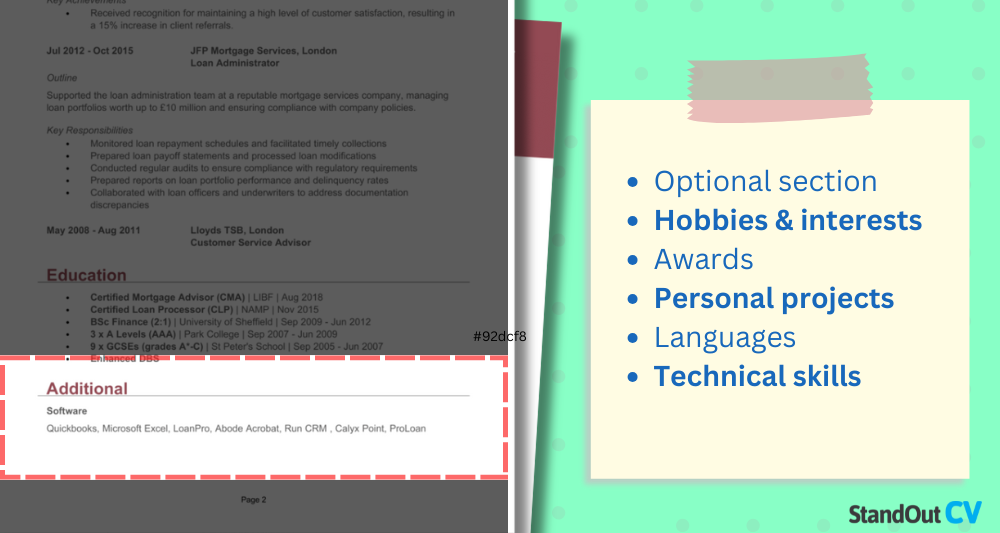
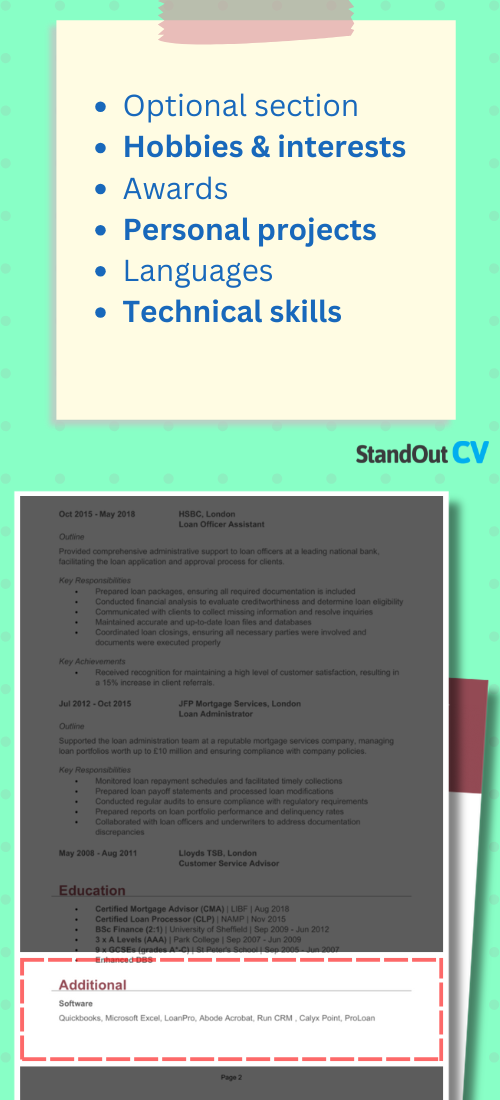
For high school students with little or no formal work experience, the Additional Information section is a valuable opportunity to show off personality, potential, and transferable skills.
Whether it’s hobbies, achievements, or personal initiatives, this section helps employers or admissions teams understand what you’re passionate about—and what you could bring to a role or team.
Good additional info for High School Students
- Hobbies – Focus on activities that show curiosity, creativity, or teamwork—such as music, sports, gaming, or crafting. These can highlight dedication, focus, and collaboration skills.
- Awards and Achievements – Any recognition from school, sports, competitions, or creative work shows you take pride in your efforts and strive for excellence.
- Extracurricular Activities – Clubs, student groups, or school roles (like prefect or form rep) demonstrate initiative, leadership, and responsibility.
- Personal Projects – Anything you’ve pursued independently—like learning a language, starting a blog, or creating digital content—shows motivation and a strong work ethic.
Additional info example
Additional info
Hobbies
Playing the drums – Built focus and discipline through regular practice and performance with a school music group.
Creative writing – Write short stories and poems as a way to explore ideas and emotions, improving storytelling and language skills.
Gaming – Play team-based games that require strategy and communication, building quick decision-making and teamwork.
Awards and Achievements
Student of the Month – Recognised for strong effort and helpfulness across multiple subjects.
Art competition winner – Took first place in a regional school art contest, showing creativity and attention to detail.
Extracurricular Activities
Student council member – Contributed to organising events and raising student concerns in meetings with school staff.
Drama club – Performed in two school productions, building public speaking skills and confidence.
Personal Projects
Language learning – Teaching myself Japanese using online tools and apps, developing independent learning habits.
Personal blog – Created a blog to review books and share opinions on current events, strengthening written communication and critical thinking.





